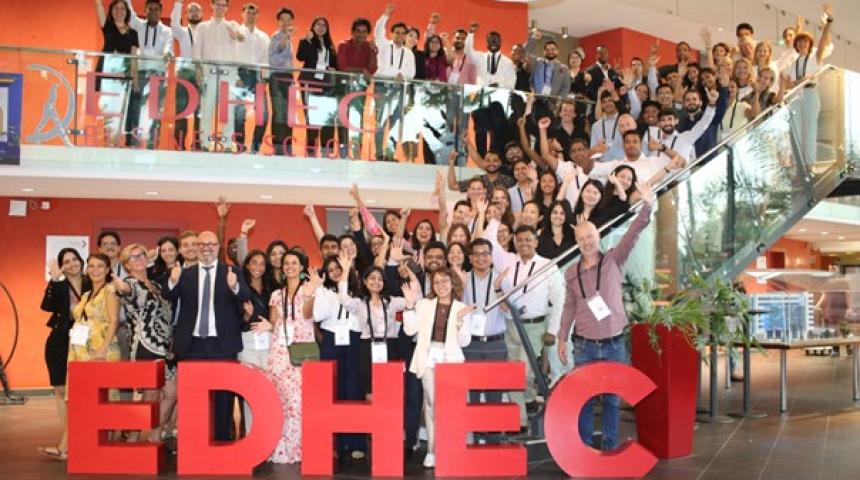Rama Cont
Usually, the doctoral students I teach are straight out of university; here we are talking about mature individuals with work experience who decided to do a PhD because they were curious about things they have been observing in their work. Such students have strong motivation, a clear idea of what they are here for; most have experience of the financial markets or other areas of finance. This makes it a nice group to teach, and it also makes teaching different from the typical experience you have in other doctoral programmes.
What are your main research areas?
My research focuses on the quantitative modelling of financial risks. I have been looking at volatility risk, credit risk, portfolio risk, as well as systemic risk and default contagion. I also have a keen interest in computational finance with an emphasis on the development of efficient simulation methods for risk management.
How is this related to the course you are teaching in the PhD programme in Finance?
Simulation methods are widely used to evaluate the risks of portfolios and investment strategies that may be exposed to interrelated risks factors. The course deals with Monte Carlo simulation methods in finance and provides an overview of the use of simulation methods in pricing and risk management and how to design and implement these methods.
What was teaching the class like?
Usually, the doctoral students I teach are straight out of university; here we are talking about mature individuals with work experience who decided to do a PhD because they were curious about things they have been observing in their work. Such students have strong motivation, a clear idea of what they are here for; most have experience of the financial markets or other areas of finance. This makes it a nice group to teach, and it also makes teaching different from the typical experience you have in other doctoral programmes. It’s also a small group with a lot of interaction between students and the instructor.
Why did you join this programme?
I have known René Garcia and Lionel Martellini for many years and decided to take up their offer join the affiliate faculty.
Did you have reservations about this programme’s being open to executives?
I would not be interested in teaching in an MBA programme. This, however, is a PhD programme. Executives in the programme often have a precise idea of the research they would like to do and of the relevance of the research to their professional goals.
You have participated in the debate on the responsibility of “quants” in the recent financial crisis – could you summarise your position in this debate?
I was discussing the responsibility of quantitative finance as a discipline; there is no collective responsibility of “quants”. The place of quantitative methods in finance and, more specifically in the decision making process of financial institutions is not completely understood by most observers. While quantitative methods have a major role to play in risk management; they were typically not given much credence by senior management. As we now know, major investment decisions were made in many large financial institutions without taking into account a proper analysis of risks. Decisions were sometimes made by people with no understanding of the models and, in many cases, without using models at all.
Through my experience consulting on and auditing risk management systems at financial institutions, I can attest that many large international investment banks have not even implemented state-of-the-art methods that are in the public domain and they have disregarded empirical knowledge, available for nearly fifty years, of the importance, frequency, and concentration of extreme risks. On the other hand, there were other financial institutions that have taken risk management seriously and have fared well during the crisis.
If anything, these observations point to an indictment of managers and regulators who failed to use the available quantitative methods, not of the models themselves. Good risk management is effective; if taken seriously and implemented appropriately quantitative models do lead to better performance. We need to take risk management seriously and do it more carefully – not measuring and not managing risks should not be an option.
In a radio interview, Dr Nassim Taleb recommended abandoning models, which he calls “bogus”, and dropping computers to “look at the world with the naked eye” – this appears to be at odds with your recommendations; is there any meeting ground between his approach and yours?
Nassim Taleb extensively quotes Benoit Mandelbrot, who back in the early 1960s, was the first to point out the existence of fat tails, volatility clustering, and other characteristics which distinguish financial series from simplistic Gaussian models. In the last fifty years, quantitative methods were developed to take these empirical facts into account and help managers make decisions… Some have understood these methods and use them; others have not, and they use the models Nassim Taleb criticises.
The technology is there, the software is there; let’s implement risk management systems that take into account extreme events. Nassim Taleb is right to point out that risk management has not always been done properly, but this does not imply that it cannot be done properly. Not measuring or not managing risk is not a reasonable proposal and I doubt that Taleb himself would take up such a proposal.
Another point Nassim Taleb makes is that, in some situations, it is very difficult to quantify risk. This goes back to Frank Knight, who established the distinction between risk and uncertainty in the early 1920s: risk is the situation when you can quantify probabilities, uncertainty is when even the probabilities are unknown.
It is fair to say that many situations exist in finance where we face uncertainty. There again, this is not grounds to condemn quantitative modelling; the focus should instead be on fostering a better understanding of the models and when and how to use them. In fact, robust decision making under uncertainty is a major research topic, which unfortunately has not sufficiently permeated the practice of risk management.
Would you have a piece of advice for doctoral students?
I would advise them to follow their interests–if they are not into a subject, then they should not go for it, even if everyone else is doing it–and select a topic that lies at the intersection of their interests and their talents.




